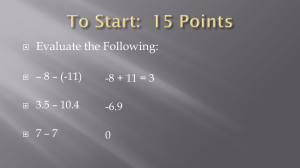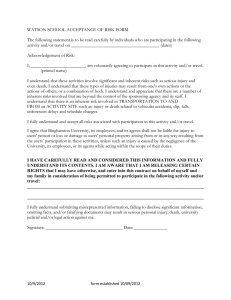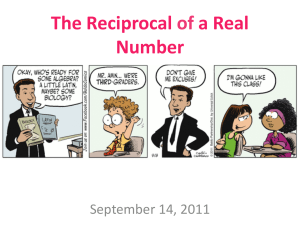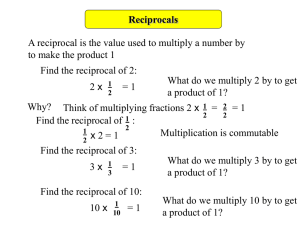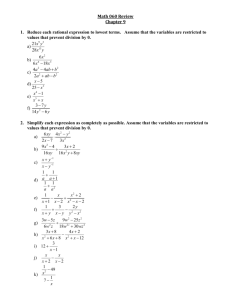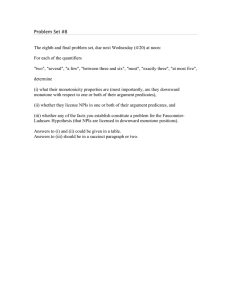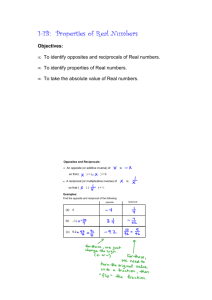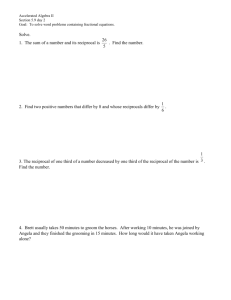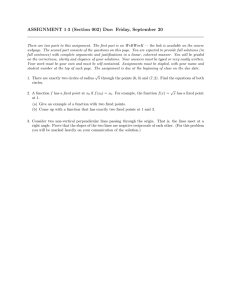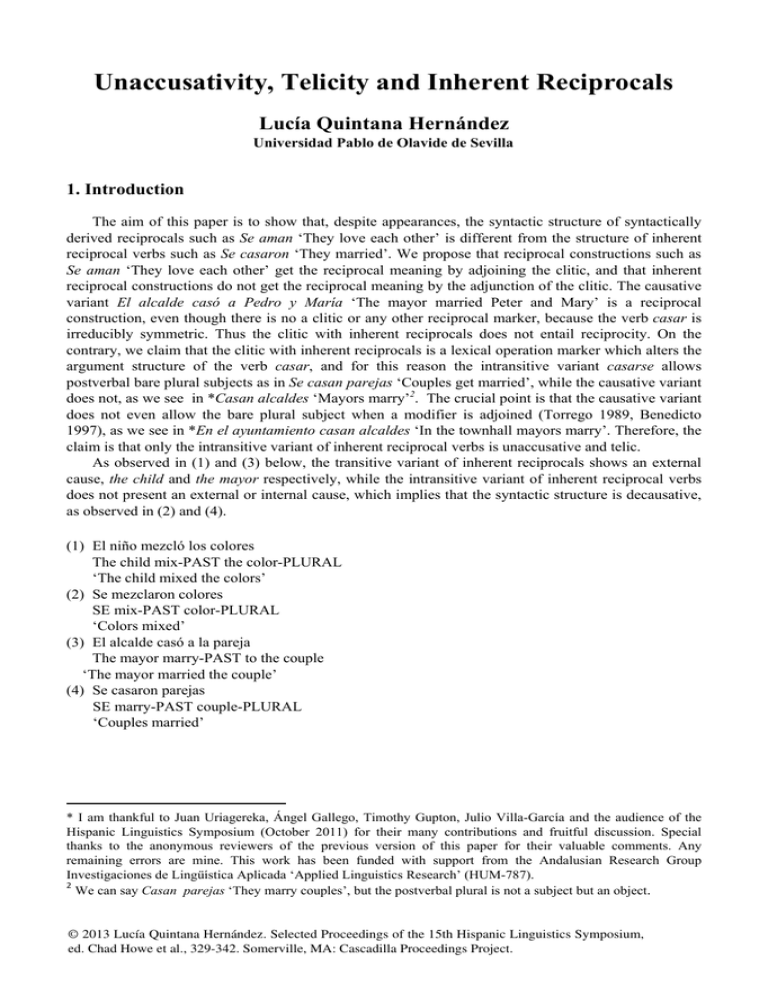
Unaccusativity, Telicity and Inherent Reciprocals
Lucía Quintana Hernández
Universidad Pablo de Olavide de Sevilla
1. Introduction
The aim of this paper is to show that, despite appearances, the syntactic structure of syntactically
derived reciprocals such as Se aman ‘They love each other’ is different from the structure of inherent
reciprocal verbs such as Se casaron ‘They married’. We propose that reciprocal constructions such as
Se aman ‘They love each other’ get the reciprocal meaning by adjoining the clitic, and that inherent
reciprocal constructions do not get the reciprocal meaning by the adjunction of the clitic. The causative
variant El alcalde casó a Pedro y María ‘The mayor married Peter and Mary’ is a reciprocal
construction, even though there is no a clitic or any other reciprocal marker, because the verb casar is
irreducibly symmetric. Thus the clitic with inherent reciprocals does not entail reciprocity. On the
contrary, we claim that the clitic with inherent reciprocals is a lexical operation marker which alters the
argument structure of the verb casar, and for this reason the intransitive variant casarse allows
postverbal bare plural subjects as in Se casan parejas ‘Couples get married’, while the causative variant
does not, as we see in *Casan alcaldes ‘Mayors marry’2. The crucial point is that the causative variant
does not even allow the bare plural subject when a modifier is adjoined (Torrego 1989, Benedicto
1997), as we see in *En el ayuntamiento casan alcaldes ‘In the townhall mayors marry’. Therefore, the
claim is that only the intransitive variant of inherent reciprocal verbs is unaccusative and telic.
As observed in (1) and (3) below, the transitive variant of inherent reciprocals shows an external
cause, the child and the mayor respectively, while the intransitive variant of inherent reciprocal verbs
does not present an external or internal cause, which implies that the syntactic structure is decausative,
as observed in (2) and (4).
(1) El niño mezcló los colores
The child mix-PAST the color-PLURAL
‘The child mixed the colors’
(2) Se mezclaron colores
SE mix-PAST color-PLURAL
‘Colors mixed’
(3) El alcalde casó a la pareja
The mayor marry-PAST to the couple
‘The mayor married the couple’
(4) Se casaron parejas
SE marry-PAST couple-PLURAL
‘Couples married’
* I am thankful to Juan Uriagereka, Ángel Gallego, Timothy Gupton, Julio Villa-García and the audience of the
Hispanic Linguistics Symposium (October 2011) for their many contributions and fruitful discussion. Special
thanks to the anonymous reviewers of the previous version of this paper for their valuable comments. Any
remaining errors are mine. This work has been funded with support from the Andalusian Research Group
Investigaciones de Lingüística Aplicada ‘Applied Linguistics Research’ (HUM-787). 2
We can say Casan parejas ‘They marry couples’, but the postverbal plural is not a subject but an object. © 2013 Lucía Quintana Hernández. Selected Proceedings of the 15th Hispanic Linguistics Symposium,
ed. Chad Howe et al., 329-342. Somerville, MA: Cascadilla Proceedings Project.
330
On the contrary, the apparent intransitive variant of other reciprocal constructions with no inherent
reciprocal verbs, obligatorily presents an external argument, as we can see in (5a) and (6a), and
postverbal bare plural subjects are not possible, as observed in (5b) and (6b):
(5) a. Los amantes se aman el uno al otro
The lover-PLURAL SE love-PRES the one the other
b. *Se aman amantes SE love-PRES lover-PLURAL
‘Lovers love each other’
(6) a. Los amantes se besan el uno al otro
The lover-PLURAL SE kiss-PRES the one the other
b. *Se besan amantes
SE kiss-PRES lover-PLURAL
‘Lovers kiss each other’
Thus, both mezclarse and casarse are decausative reciprocals derived from causative casar and
mezclar, as one can infer from a comparison of (1)-(2) and (3)-(4). Notice that only (1) and (3) show an
explicit external cause, the child and the mayor, respectively. Our claim is that the sentences in (2) and
(4) are unacussative because there is no external argument, as the possibility of postverbal bare plural
nominals show in (2) and (4). Bearing in mind that reciprocals require a Proto-Agent (Dowty 1991,
Quintana Hernández 2010), it must be the case that decausative inherent reciprocals are possible
because there is an implicit external cause. We claim this is the reason why we have a clitic which
inherits the features of the external argument.
On the contrary, derived reciprocals, as seen in (5) and (6), do not accept postverbal bare plurals,
which implies that they are not unaccusative but unergative (Siloni 2008, Quintana Hernández 2012).
As expected if only predicates with a Proto-Agent can be reciprocated, the use of uno P otro to get
derived reciprocals is very productive with transitive predicates like amar ‘love’ and besar ‘kiss’, as we
have seen previously, and unergative predicates like trabajar ‘work’ in Spanish, but not with
unaccusative predicates like crecer ‘grow’, as you can see below:
(7) Los muchachos trabajan unos con otros
The boy-PLURAL work-PRES one-PLURAL with other-PLURAL
‘The boys work with each other’
(8) *Las flores crecieron unas a/con/para otras
The flower-PLURAL grow-PAST one-PLURAL to/with/for other-PLURAL
‘The flowers grew with each other’
In fact, we must say that there is a very limited set of verbs which allow the transitive alternation
seen in (1)-(4) in Spanish. The enlightening assertion is that all inherent decausative reciprocal verbs
allow this alternation, i.e. all of them are unaccusative.
Apart from cause recovering, the clitic se is also an aspectual marker which indicates that the event
has an endpoint. That is the reason why most reciprocal sentences with inherent reciprocal verbs are
telic, as observed in Se mezclaron en un segundo ‘They mixed in a second’, while we do not find
telicity effects with all other reciprocal predicates, as we see in *Se amaron en un año ‘*They love each
other in one year’. Our claim, thus, is that se with inherent reciprocal verbs is different from the clitic se
with all other derived reciprocal predicates.
331
In sum, the aim of this paper is to show that the syntactic structure of the intransitive variant of
inherent reciprocals is unaccusative. These unaccusative structures derive from object-oriented
reciprocals such as casar ‘marry’, mezclar ‘mix’, unir ‘unite’, separar ‘separate’, etc. First, we will
show several unaccusativity tests that prove that intransitive inherent reciprocals are unaccusative:
postverbal bare plurals, absolute participles constructions and the impossibility of agent suffixes such as
–dor, -dora, -nte, etc. Second, we will test these unaccusative constructions to show that they are
indeed telic. This fact supports the claim that correlates unaccusativity and telicity and the claim that
aspectual features have to be included in the computation (Guéron 2005). Third, we will review
Guéron’s (2005) proposal for aspectual computation. Finally, we will propose the syntax of aspect for
decausative inherent reciprocal sentences.
2. Unaccusativity diagnostics
In this section we will see that unaccusativity diagnostics demonstrate that, as expected, only
inherent reciprocals are unaccusative. Since there are not too many phenomena sensitive to
unaccusativity in Spanish we will rely on all the tests traditionally used (Torrego 1989, Bosque &
Gutiérrez-Rexach 2009): the possibility to appear in absolute participle constructions, the ability to
appear with bare plurals in postverbal position, and the inability to appear with agentive suffixes such
as –dor, -dora, -nte, etc.
2.1. Inherent reciprocals and absolute participle constructions
Absolute participle constructions can occur with unaccusative predicates but not with unergative
predicates, as evidenced in (9)-(10). As expected if our hypothesis is on the right track, only inherent
reciprocals allow absolute participle constructions as evidenced in (11) and (12) below:
(9) Muerto el perro, se acabó la rabia
Dead the dog, SE finish-PAST rabies
‘Once the dog is dead, rabies finished’
(10) *Trabajado el estudiante, aprobó el curso
Worked the student, pass-PAST the course
‘Once the student has studied, he has passed the course’
(11) Una vez casados, se fueron de luna de miel
Once marry-PAST-PLURAL, SE go-PAST on honeymoon
‘Once they married, they went on honeymoon’
(12) Una vez separados, rehicieron sus vidas
Once separate-PAST-PLURAL, remake-PAST their life-PLURAL
‘Once they divorced, they remade their lives’
On the contrary, derived reciprocal constructions do not allow absolute participle constructions, as
observed in (13)-(14).
(13) *Una vez besados, hicieron las paces
Once kiss-PAST-PLURAL, reconcile-PAST
‘Once kissed, they reconciled’
(14) *Una vez queridos, decidieron estar juntos
Once love-PAST-PLURAL, decide-PAST to be together
‘Once loved, they decided to be together’
332
2.2. Inherent reciprocals and bare plurals in postverbal position
As pointed out by Benedicto (1997), bare plurals can appear postverbally with any kind of
predicate in Spanish. However, bare plural subjects in postverbal position can occur with unaccusative
predicates but not with unergative predicates, unless a locative modifier is inserted, as observed in (15)(18). Hence, unergative predicates accept bare plurals in postverbal position if a locative is inserted in
preverbal position (Torrego 1989) or postverbal position (Benedicto 1997).
(15) Mueren animales todos los días
Die-PRES animals every day
‘Animals die every day’
(16) *Trabajan secretarias
Work-PRES secretary-PLURAL
‘Secretaries work’
(17) Aquí trabajan secretarias
Here work-PRES secretary-PLURAL
(18) Trabajan secretarias aquí
Work-PRES secretary-PLURAL here
‘Secretaries work here’
These facts show that postverbal bare plurals make a distinction between the two types of
intransitive predicates. “The intuition is that certain kinds of modification allow a bare plural to appear
in the postverbal position of an unergative verb, but that this modification is not necessary for licensing
a bare plural subject when the verb is unaccusative” (Armstrong 2011: 7). Only predicates that have an
object allow bare plurals postverbally without restrictions. It is not our purpose to explain this
phenomenon here, but to use bare plurals as a true unaccusativity diagnostic and demonstrate that
decausative inherent reciprocals are unaccusative, and subsequently allow bare plurals in postverbal
position, as in (19) and (20):
(19) Se casaron parejas
SE marry-PAST couple-PLURAL
‘Couples married’
(20) Se mezclaron colores
SE mix-PAST color-PLURAL
‘Colors mixed’
As observed in (19)-(20), bare plural subjects in postverbal position can occur with unaccusative
inherent reciprocals but not with unergative derived reciprocals, as illustrated in (21) and (22).
(21) *Se besan niños
SE kiss-PRES child-PLURAL
‘Children kissed’
(22) *Se aman parejas
SE love-PRES couple-PLURAL
‘Couples love’
333
2.3. Inherent reciprocals and agentive suffixes
As it can be observed in (23) and (24), agentive affixes are not possible with unaccusative
predicates but only with unergative. As expected, only derived reciprocals allow agentive affixes3, as
we can see in (25) and (26) below, while unaccusative inherent reciprocals disallow agentive
nominalizations, as in (27)-(31):
(23) trabajador/trabajadora
worker (masculine)/ worker (feminine)
(24) *moridor/*moridora
Dier (masculine)/ dier (feminine)
(25) amante
lover
(26) vidente
seer
(27) *casador/*casadora/*casante
marrier
(28) *mezclador/*mezcladora/*mezclante
mixer
(29) *unidor/*unidora/*unante
unifyer
(30) *divorciadora/*divorciante
divorcer
(31) separador/*separadora
separator
As observed, only transitive and unergative predicates allow the agentive nominalization. As
expected if inherent reciprocals are unaccusative, the agentive suffixes cannot occur with casar,
mezclar, unir, divorciar, etc. Nonetheless, we have the possibility to add the agentive suffix –dor to the
predicate separar in (31). We argue that the fact that separar cannot occur with the feminine suffix –
dora shows that –dor with separar is not an agentive suffix in this case. In fact, separador is an object,
a sort of folder used to order things.
Having presented diagnostics to test that inherent reciprocals are unaccusative, let us turn to
diagnostics to prove that they are telic.
3. Telicity diagnostics
As already said, in this section we will see that telicity diagnostics demonstrate that, as previously
argued, inherent reciprocals are telic. We will rely on some of the tests traditionally used (see Marín &
McNally 2011 and references therein): en/durante ‘in/for’ adverbials, infinitival complement of
acabar/terminar ‘finish’, and compatibility with una vez ‘once’ absolutes.
3
Not all derived reciprocals allow agentive suffixes, e.g.*besante, *criticador, etc.
334
3.1. En/durante ‘in/for’ adverbials
Telic predicates are those predicates which have an endpoint and therefore accept en ‘in’
adverbials, while atelic predicates do not; they accept durante ‘for’ adverbials instead. Let´s observe the
behavior of inherent reciprocal predicates in this regard:
(32) Se mezclaron en un minuto/*durante un minuto
SE mix-PAST in a minute/for a minute
‘They mixed in a minute/*for a minute’
(33) Se casaron en un minuto/*durante un minuto
SE marry-PAST in a minute/for a minute
‘They married in a minute/*for a minute’
(34) Se unieron en un minuto/*durante un minuto
SE unite-PAST in a minute/for a minute
‘They united in a minute/*for a minute’
(35) Se divorciaron en un minuto/*durante un minuto
SE divorce-PAST in a minute/for a minute
‘They divorced in a minute/*for a minute’
As observed in (32)-(35) inherent reciprocals pattern with telic predicates which means that all of
them are punctual predicates. Interestingly, all of these predicates allow the progressive form as
observed below:
(36) Los colores están mezclándose ahora mismo
The color-PLURAL are mix-PROGRESSIVE.SE right now
‘Colors are mixing right now’
(37) Se están casando ahora mismo
SE are marry-PROGRESSIVE right now
‘They are marrying right now’
(38) Se están uniendo
SE are unite-PROGRESSIVE
‘They are uniting’
(39) Se están divorciando
SE are divorce-PROGRESSIVE
‘They are divorcing’
We claim that the possibility of the progressive shows that decausative inherent reciprocals are
change of state predicates which therefore also refer to circumstances before the event is accomplished.
The possibility of using the progressive with inherent reciprocals also shows that apart from being telic
predicates they are also dynamic which means that they have some duration as the possibility of using
durante ‘for’ adverbials in the following example shows:
(40) Los colores estuvieron mezclándose durante horas
The color-PLURAL were mix-PROGRESSIVE for hour-PLURAL
‘Colors were mixing for hours’
335
(41) Se casaron durante el verano4
SE marry-PAST for the summer
‘They married for the summer’
Subsequently, it is no surprise that we find some inherent reciprocals which accept both en ‘in’
adverbials and durante ‘for’ adverbials, as observed below:
(42) Se separaron en un minuto/durante un minuto
SE separate-PAST in a minute/for a minute
‘They separated in a minute/for a minute’
(43) Se juntaron en un minuto/durante un minuto
SE join-PAST in a minute/for a minute
‘They joined in a minute/for a minute’
3.2. Infinitival complement of acabar/terminar ‘finish’
Since telic predicates have an endpoint they are compatible with the meaning of acabar and
terminar ‘finish’, and therefore they can appear as infinitival complements to these verbs, while atelic
predicates cannot. Let us observe the behavior of inherent reciprocal predicates in this regard:
(44) Acaban de mezclarse/ casarse/ divorciarse/ separarse/ unirse/ juntarse
Finish-PRES mixSE/ marrySE/ divorceSE/ separateSE/ uniteSE/ joinSE
‘They finish mixing/ marrying/ divorcing/ separating/ uniting/ joining’
As observed in (44), inherent reciprocals are compatible with acabar. An anonymous reviewer
suggests these examples are ambiguous. They can mean ‘They just got mixed/married’ and also ‘They
finished mixing/marrying’. However different they might look like, both interpretations imply change
of state and focus on the beginning of a new state, and therefore, both meanings imply that They are
mixed/married.
Even though inherent reciprocals are compatible with acabar, they are not compatible with
terminar, as seen below:
(45) *Terminan de unirse/ juntarse/ divorciarse
Finish-PRES uniteSE/ joinSE/ divorceSE
‘They finish uniting/ joining/ divorcing’
We do not have an explanation for these cases, but intuitively we claim that it has to do with the
aspectual specifications of the verb terminar which we will not go into now. Interestingly, according to
the same anonymous reviewer, for some speakers some examples are grammatical if the preterite is
used, as seen in Terminaron de separarse/mezclarse ‘they finish separating/mixing’, which, from my
perspective, suggests that it has to do with the computation of aspect (lexical aspect and grammatical
aspect).
3.3. Compatibility with una vez ‘once’ absolutes
Since telic predicates have an endpoint they are compatible with una vez ‘once’ absolutes, while
atelic predicates are not, as observed below:
4
Thanks to an anonymous reviewer for this example.
336
(46) Una vez mezclados, úsalos cada dos días
Once mix-PAST-PLURAL, use-IMPERATIVE every two day-PLURAL
‘Once they are mixed, use them every other day’
(47) Una vez casados, se fueron de luna de miel
Once marry-PAST-PLURAL, SE go-PAST on honeymoon
‘Once they were married, they went on honeymoon’
(48) Una vez divorciados, rehicieron sus vidas
Once divorce-PAST-PLURAL, remake-PAST their life-PLURAL
‘Once they were divorced, they remade their lives’
(49) Una vez unidos, nada los separará
Once unite-PAST-PLURAL, nothing them separate-FUTURE
‘Once they are united, nothing will separate them’
(50) Una vez separados, será imposible volver a unirlos
Once separate-PAST-PLURAL, be-FUTURE impossible to reunite them
‘Once they are separated, it will be impossible to reunite them’
(51) Una vez juntados, será imposible separarlos
Once join-PAST-PLURAL, be-FUTURE impossible to separate them
‘Once they are joined, it will be impossible to separate them’
As observed in (46)-(51), this diagnostic works for all inherent reciprocals. This fact, together with
those examined previously, strongly suggest that inherent reciprocals are telic and dynamic and that
therefore, aspectual features should be taken into account in the syntactic component, as we will see in
the next section.
Be that as it may, it seems that inherent reciprocals should not be considered achievements, but
accomplishments, meaning that they are not spontaneous eventualities, as the use of the progressive
shows, but somehow telic predicates which have duration and focus on the onset of the event. Thus,
there is an important difference between casarse ‘marry’ and estar casado ‘to be married’, separarse
‘separate’ and estar separado ‘to be separated’, only the meaning of casarse and separarse includes
both reference to the previous circumstance and the beginning of a new state, as said before. Therefore,
we propose that inherent reciprocals such as casarse are inchoative and that the clitic is an aspectual
element (Kempchinsky 2004, Armstrong 2011).
Given the relevance of aspectual features differentiating reciprocal verbs from other verbs, let us
assume that those features, together with the [symmetry] feature, are inserted in the syntactic
computation.
4. The syntax of aspect
According to Guéron (2005), predicates have a formal feature which translates lexical content in
terms of extension in space and time. This formal feature is an abstract number feature [+/- plural]
construed as an Aktionsart feature [+/- EXT(ended)] which differentiates telic predicates from atelic
predicates. Thus, predicates which are extended in space and time like swim for hours, are atelic, while
those ones not extended in space or time like arrive at ten o clock are telic. Furthermore, and in her own
words, “the lexical material in vP and TP is organized and placed in space and time by an external
argument located at the periphery of each syntactic phase” (Guéron 2005: 92). A VP with a [+EXT]
Aktionsart F selects a subject in [Spec vP], while a VP with a [-EXT] Aktionsart F does not. Thus, for
example, a predicate such as have will be interpreted spatially or temporally depending on the syntactic
position it is merged, as we see below:
(52) John has the book in his hand
337
(53) John has broken the teapot (from Guéron 2005: 90)
As observed in (52), the predicate have is merged in VP and its interpretation is spatial, while in
(53) it is merged in TP and, consequently, it is interpreted temporally. Following her proposal, the
predicate have is [-pl][-EXT] in (52), and subsequently does not select an external argument in[Spec
vP], while the predicate break is a [+pl] [+EXT] and it does select an external argument in vP which
functions as Manipulator, one of the several event functions Guéron proposes to substitute theta roles.
External arguments situated in [Spec vP] function as Manipulator and Instrument, while external
arguments situated in [Spec TP] function as Trigger and T-Controller through the temporal feature in
nominals, i. e. the person feature. This way, Guéron eliminates holistic theta-role features assigned to a
predicate in the lexicon and favours fragmentary event functions or roles which select an external
argument in one or more syntactic phases. Thus, the calculation of aspect takes place throughout the
whole computation, as expected if aspect is more than just an Aktionsart feature (Akt F).
Following Vendler’s typology, Guéron claims that activities like swim are [+pl][+EXT],
accomplishments like read are also [+pl][+EXT], while achievements like hit and arrive, transitive and
unaccusative respectively, are [-pl][-EXT]. States are also [-pl][-EXT]. However, we claim that even
though accomplishments are initially [+pl][+EXT], they become telic because of the presence of an
internal argument which delimits the event (Tenny 1994).We assume that the feature specification of
accomplishments becomes [+pl][-EXT] whenever the internal argument is a definite NP.
All in all, Guéron puts the stress upon the interface of syntax and semantics by claiming that “the
situation the sentence describes is placed in the space and time intervals associated with the discourse
world” (Guéron 2005: 89). She proposes that the “Interface constraint determines the valence of a verb,
and how spatial construal in vP interacts with temporal construal in TP” (Guéron 2005: 96).
(54) Interface constraint
vP must define a spatial Figure-Ground configuration (Guéron 2005: 96).
Thus, for example,
swimming implies gestures effected by the arms, legs and torso of a swimmer, which
constitute the Figure of a spatial configuration. As swim implies the water which
functions as GROUND, its FIGURE-GROUND configuration is complete without a
direct object in VP (Guéron 2005: 96).
Even though Guéron only focuses on the external argument and does not pay attention to the
contribution of the internal argument, we will take her proposal for the syntax of aspect because it takes
into account all sorts of aspect, not only Aktionsart, but grammatical aspect through person feature
checking, and discourse aspect beyond TP. Since we are dealing with decausative reciprocals we will
try to focus on verbal quantification and the contribution of the internal argument to aspect
computation.
5. The syntax of aspect in inherent decausative reciprocals
Since the complexity of thematic roles with inherent reciprocals is about irreducible symmetry, we
argue that these verbs enter the derivation with the feature [symmetry] which entails that when the
FinP/TP phase gets the C-I component, it gets the intended interpretation. A predicate with the
[symmetry] feature entails that the components of the plural nominal play different aspectual functions.
As already said, decausative inherent reciprocals are also telic, specifically they are accomplishments.
All in all, the fact that, as accomplishments, inherent reciprocals are marked with plural abstract
338
number [+pl] in terms of Guéron (2005) is supported by the fact that inherent reciprocals are
obligatorily lexical plural predicates (Kratzer 2008).
Even though inherent reciprocals do not require any pluralizing reciprocal expression, the clitic se
is obligatory with decausative reciprocals. We assume that the clitic is an inner aspectual marker, i.e. a
lexical pluriactional operator (Laca 2006) comparable to diez (ten) in diezmar (kill ten), which must be
merged as the head of inner AspP. That means that inner aspect is a number feature on verbs (not
morphological agreement), specifically what Guéron calls the abstract feature [+/-pl] construed as an
Aktionsart feature [+/-EXT], which translates lexical content in terms of extension in space and time. If
our assumption is right and decausative reciprocals are unaccusative and telic, specifically
accomplishments, the number feature will be [+pl][+EXT]. The addition of a definite internal argument
will give us a derived Akt F [+pl][-EXT].
Additionally, we claim that the clitic promotes decausativization and that decausativization is a
lexical operation which alters the argument structure: V loses the accusative case and the external
argument (Burzio’s generalization) (Cinque 1988, Grimshaw 1990, among others), and the clitic
inherits the person feature of the external argument (Kempchinsky 2004). Apart from the pluralizing
effect of se, we argue that whenever the clitic promotes this lexical operation, vP is substituted by AspP
and there is no external argument to merge. Thus, AspP only appears when there is an aspectual marker
such as se. Furthermore, we assume that T loses φ features (Raposo and Uriagereka 1996) and that,
subsequently, the internal argument needs to get rid of φ features and case somewhere above TP,
supposedly FinP (López 2007, 2009). In other words, we claim that AspP is defective vP, which entails
that extraction out of it is possible with no phase constraints violation (Chomsky 2004). Hence, this
analysis finds further support to believe that unaccusative vP is not a phase.
We now examine the syntactic derivation of the AspP (inner aspect) of a decausative inherent
reciprocal predicate:
(55) Juan y María se casaron.
AspP
se
[+pl][-EXT]
[pers]
VP
V
DP
casar Juan y María
[+pl][+EXT] [+pl][-EXT]
[symmetry] [symmetry]
[case]
[gen]
[num]
[pers]
[discourse]
As observed, the accomplishment casar ‘marry’ is merged with its abstract number feature [+pl],
which in Guéron’s (2005) proposal means that casar consists of a plurality of acts which constitute the
FIGURE of a spatial configuration. The GROUND of the marrying activity is, inherently, a couple, i.e.
339
the internal argument Juan y María. Because there is a definite internal argument, the predicate Akt F
becomes [-EXT], which means that we do not need an external argument which delimits the spatial
configuration and function as its Manipulator (one of the aspectual functions attributed to Agents in
Gueron's proposal), but a T-controller in [Spec TP] or [Spec FinP], i.e. a discourse related function that
it is introduced in the computation by an interpretable discourse feature, as proposed by López for
dislocated subjects that initiate a new discourse.
As already assumed, the clitic se is merged as the head of AspP to ensure pluriactionality5, which
means that the clitic entails the plurality of subevents that make up the macroevent of marrying. Given
that lexical cumulativity allows the sum of the marrying parts, i.e. John married Mary and Mary
married John, no further pluriactional operator such as uno P otro ‘each other’ is needed to get the
reciprocal interpretation, i.e. the pluriactional operator uno P otro is optional with inherent reciprocals.
As expected, this particular event of marrying is delimited by its internal argument. Only when the
internal argument is a definite NP does the inherent reciprocal become an accomplishment; otherwise,
it would be an activity as observed in Aquel día se casaron parejas durante horas ‘That day couples
married for hours’.
Now that lexical items are merged, unvalued features need to be valued through Agree for the
derivation to get rid of them before spell-out takes place. Recall that V has lost its ability to assign
accusative and consequently the internal argument has to raise somewhere to delete its valued case, i.e.
it needs to look for a probe to establish a dependency with. As already said, we argue that the
unaccusative structure under AspP is not a phase (Chomsky 2004, Gallego 2010), and subsequently,
Agree between a probe in FinP/TP and a goal in AspP/VP is allowed (see Legate for an alternative
view). We might argue that the internal argument moves to [Spec TP] to delete its case. However, in
accordance with Raposo and Uriagereka’s (1996) proposal for indefinite se, we argue that the internal
argument of decausative reciprocals moves beyond [Spec TP] because subjects in that position can
never be bare NPs, and bare NPs can be subjects of inherent reciprocals, as we have seen before in Se
casaron parejas. Instead, we assume that the internal argument further moves to [Spec FinP] to value φ
features and an interpretable discourse feature which López (2009) proposes for hanging topics, while
the person feature is valued in situ6.
There are good reasons to think that dislocated subjects with inherent reciprocal verbs are left
dislocated hanging topics. Under the assumption that left dislocated hanging topics are insensitive to
islands (López 2009:130), we can construct some examples that show that pre-verbal subjects of
decausative inherent reciprocals are hanging topics, as seen below:
(56) Los colores, me dijo Ana que se mezclaron
The color-PLURAL, me say-PAST-SINGULAR Ana that SE mix-PAST-PLURAL
‘The colors, Ana told me that they were mixed’
Los colores ‘the colors’ is interpreted as the subject of the subordinate sentence introduced by que
‘that’, thus it must be a hanging topic that is not sensitive to islands constraints. In contrast, the preverbal subject of derived reciprocals is sensitive to islands and does not allow such constructions, as
seen below:
5
Alternatively, it might be argued that a defective null pronominal is merged in [Spec AspP] (see López 2007 and
Mendikoetxea 2008 for an analysis along these lines) so that we have a defective external argument which
functions as a defective Manipulator, supposedly someone else, as it is implicit if we say Juan y María se casaron
(John and Mary married). That utterance is only truth if someone else (a priest or a mayor, for example) married
the couple. However, we will not pursue that view since a [-EXT] predicate does not need an external argument in
that position but a T-controller, as already argued.
6
We assume that the null pronominal pro moves to [Spec FinP] when there is no internal argument.
340
(57) *Juan y María, me dijo Ana que se quieren
John and Mary me say-PAST-SINGULAR that SE love-PAST-PLURAL
‘John and Mary, Ana told me that they love each other’
López (2009) proposes that pre-verbal subjects move to [Spec Fin] to value a discourse feature that
means ‘initiate a discourse’ and the contrast in (56)-(57) shows that only inherent reciprocal subjects
are topics indeed. Therefore, only pre-verbal subjects of decausative inherent reciprocals move first to
[Spec TP] to value case and afterwards to [Spec Fin] to value the interpretable discourse feature.
Furthermore, the feature [pers] of the clitic and the internal argument is valued through Multiple
Agree established between the head of TP as a probe and se and the internal argument as two goals with
the same unvalued feature. This way, we get the complex dependency attested between the clitic and
the internal argument.
Let´s see the tree diagram for the whole structure.
(58) Juan y María se casaron.
FinP
Juan y María
[discourse]
[φ features]
TP
[case]
T
[pers]
[tense]
se casaron
AspP
t
[+pl][-EXT]
VP
t
[+pl][+EXT]
[symmetry]
t
[pers]
[+pl][-EXT]
[symmetry]
As observed in (58), there is a person feature which draws together several items that have been
copied in T: the internal argument and Asp. The movement of the clitic to the head of T because of the
person feature might be related to requirements of the A-P component, which we will not go into in this
work. The person feature of the internal argument gets valued in its position by the probe in T, as
already assumed.
Following Guéron’s proposal (2005), apart from needing a T-controller in [Spec TP], unaccusatives
require an extra aspectual function, a CP T-controller which she names Speaker. Our proposal departs
from hers in that what she names T-controller, i.e. the external argument in [Spec TP], sits in [Spec
FinP]. The displaced internal argument in [Spec FinP] as T-controller is the only aspectual function
which an unaccusative predicate needs to satisfy. Intuitively, the T-controller introduces the point of
view of the speaker who utters such a sentence, i.e. it introduces a related discourse function that
341
initiates a new discourse (López 2009). Further research on the left periphery of unaccusative
reciprocals will reveal whether there is another aspectual function which the displaced internal
argument needs to satisfy. Additionally, the fact that this internal argument is a definite DP together
with the Akt [+pl][-EXT] feature ensures telicity, while the symmetry feature ensures that the
individuals included in the plural internal argument exchange roles in the multiple actions. How the C-I
component gets the intended interpretation is something which also remains to be done in future
research.
6. Concluding remarks
We have shown that inherent reciprocals such as casarse, mezclarse, etc. are unaccusative and
telic, and more specifically, are accomplishments. We have also shown that this particular behavior is
motivated by a lexical decausativization operation which inserts an inner aspect clitic that inherits the
person feature of the external argument. Thus, inherent decausative reciprocal predicates do not become
symmetrical because of the clitic, as it happens for all other reciprocal constructions such as Se aman
‘They love each other’. Rather, they are inherently irreducible symmetric predicates that are inserted
with interpretable plural abstract number features ([+pl] [+EXT]) and symmetric features, which,
together with the event function of T-controller in [Spec FinP] introduced by the discourse feature,
account for the reciprocal meaning without using thematic roles. The [+pl] feature is the inner aspect
feature which lexically pluralizes the predicate. The [symmetry] feature ensures that the C-I component
interpretation allows that the participants in the event of marrying are equally involved. Furthermore,
having a definite internal argument ensures that the event is telic. As already said, how the C-I
component reads the phrase structure and the interpretable features to get the intended meaning remains
to be done.
This analysis is specific to Spanish reciprocal verbs, and the predictions are that all decausative
inherent reciprocal verbs are unaccusative and telic, and subsequently their subjects have different
syntactic and semantic properties from other reciprocal constructions. Future research on reciprocal
data will show whether these predictions are borne out not only for decausative reciprocals in Spanish
but for other inchoative se constructions in Spanish and other romance languages that also have
inchoative/ergative se.
References
Armstrong, Grant Warren. 2011. Two classes of transitive verbs: Evidence from Spanish. Unpublished Ph. D
dissertation. Georgetown University.
Benedicto, Elena. 1997. “Verb Movement and its Effects on Determinerless Plural Subjects”. Armin Schwegler
Bernard Tranel & Miriam Uribe-Etxebarría (eds.). Romance Linguistics. Current issues in Linguistic Theory
160. Irvine: John Benjamins, pp.55-40.
Bosque, Ignacio. & Gutiérrez-Rexach, Javier. 2009. Fundamentos de sintaxis formal. Madrid: Akal.
Chomsky, Noam. 2004. “Beyond Explanatory Adequacy”. Adriana Belletti (ed.). Structures and Beyond. The
Cartography of Syntactic Structure, Vol 3. Oxford: OUP, pp. 104-131.
Cinque, Gugliermo. 1988. “On Si Constructions and the Theory of Arb”. Linguistic Inquiry, 19, 521-581.
Dowty, David. 1991. “Thematic Proto-Roles and Argument Selection”. Language 67 (3), pp. 547-619.
Gallego, Ángel. 2010. Phase Theory. Amsterdam: John Benjamins.
Grimshaw, Jane. 1990. Argument Structure. Cambridge, Mass: MIT Press.
Guéron, Jacqueline. 2005. “Tense, Person and Transitivity”. Nomi Erteschik-Shir & Tova Rapoport (eds.) The
Syntax of Aspect: Deriving Thematic and Aspectual Interpretation. Oxford Studies in Theoretical
Linguistics.Oxford: OUP, pp. 89-116.
Kempchinsky, Paula. 2004. “Romance Se as an Aspectual Element”. Auger, J. et al., eds. Contemporary
Approaches to Romance Linguistics. Amsterdam/Philadelphia: John Benjamins, 239-256.
342
Laca, Brenda. 2006. “Pluralidad y aspecto verbal en español”, Revista Española de Lingüística 36, pp. 7-41.
Legate, Julie. 2003. “Some interface properties of the phase”. Linguistic Inquiry 34 (3) pp. 506-516.
López, Luis. 2009. A Derivational Syntax for Information Structure. Oxford Studies in Theoretical Linguistics.
New York, OUP.
López, Luis. 2007. Locality and the Architecture of Syntactic Dependencies. New York, Pallgrave McMillan.
Kratzer, Angelika. 2008. “On the Plurality of Verbs”. Johannes Dölling, Tatjana Heyde-Zybatow & Martin Schặfer
(eds.) Language Context and Cognition. Event Structures in Linguistic Form and Interpretation. Berlin:
Mouton de Gruyter, pp. 269-301.
Marín, Rafael. & McNally, Louisse. 2011.”Inchoativity, Change of State and Telicity: Evidence from Spanish
Reflexive Psychological Verbs”. Natural Language and Linguistic Theory 29, pp. 467-502.
Mendikoetxea, Amaya. 2008. “Clitic Impersonal Constructions in Romance: Syntactic Features and Semantic
Interpretation”. Transactions of the Philological Society 106 (2), pp. 290-336.
Quintana Hernández, Lucía. 2010. “Aktionsart, agentividad y reciprocidad en español”. Philologia Hispalensis
XXIV, pp. 143-167.
Quintana Hernández, Lucía. 2012. “El aspecto en las construcciones recíprocas del español”. Verba: Anuario
Galego de Filoloxia, 39, pp. 63-82.
Raposo, Eduardo & Uriagereka, Juan. 1996. “Indefinite se”. Natural Language and Linguistic Theory 14, pp.749810.
Siloni, Tali. 2008. “The Syntax of Reciprocal verbs: An Overview”. Ekkehard König & Volker Gast (eds.) Trends
in Linguistics. Reciprocals and Reflexives: Theoretical and Typological Explorations. Berlin: Mouton de
Gruyter, pp. 451-499.
Tenny, Carol. 1994. Aspectual Roles and the Syntax-Semantics Interface. Studies in Linguistics and Philosophy
52. Dordrecht: Kluwer Academic Publishers.
Torrego, Esther. 1989. “Unergative-Unaccusative Alternations in Spanish”. MIT Working Papers in Linguistics,
Functional Heads and Clause Structure, pp. 253-272. Selected Proceedings of the
15th Hispanic Linguistics Symposium
edited by Chad Howe, Sarah E. Blackwell,
and Margaret Lubbers Quesada
Cascadilla Proceedings Project
Somerville, MA
2013
Copyright information
Selected Proceedings of the 15th Hispanic Linguistics Symposium
© 2013 Cascadilla Proceedings Project, Somerville, MA. All rights reserved
ISBN 978-1-57473-457-7 library binding
A copyright notice for each paper is located at the bottom of the first page of the paper.
Reprints for course packs can be authorized by Cascadilla Proceedings Project.
Ordering information
Orders for the library binding edition are handled by Cascadilla Press.
To place an order, go to www.lingref.com or contact:
Cascadilla Press, P.O. Box 440355, Somerville, MA 02144, USA
phone: 1-617-776-2370, fax: 1-617-776-2271, sales@cascadilla.com
Web access and citation information
This entire proceedings can also be viewed on the web at www.lingref.com. Each paper has a unique document #
which can be added to citations to facilitate access. The document # should not replace the full citation.
This paper can be cited as:
Quintana Hernández, Lucía. 2013. Unaccusativity, Telicity and Inherent Reciprocals. In Selected Proceedings
of the 15th Hispanic Linguistics Symposium, ed. Chad Howe et al., 329-342. Somerville, MA: Cascadilla
Proceedings Project. www.lingref.com, document #2895.

